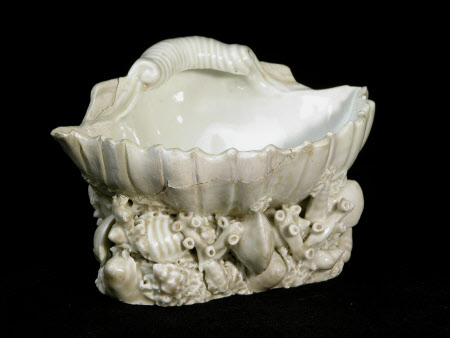Salt
Plymouth Porcelain Factory
Category
Ceramics
Date
1768 - 1770
Materials
hard paste porcelain
Measurements
70 x 70 mm; 90 mm (Length)
Place of origin
Plymouth
Order this imageCollection
Saltram, Devon
NT 870975.2
Summary
White glazed, hard-paste porcelain single shell salt cellar made at the Plymouth porcelain factory 1768-1770. Single moulded scallop shell set into a base decorated with smaller shells and corals. Grey, discoloured glaze a result of smoke staining during the firing process. One of a pair. The Saltram Collection (1967): 282, p.63
Full description
The Plymouth Porcelain factory was established by William Cookworthy (1705-1780) in 1768. It was the first to produce so-called ‘hard paste’, or ‘true’ porcelain in the UK. This meant that it combined the materials of china clay (kaolin) and china stone (petunse) to produce a hard-fired body to the same recipe as Chinese porcelain. Many European factories attempted to re-create Chinese porcelain which was famed for its translucency and much in demand. The recipe for porcelain was a closely guarded secret. Only a handful of factories managed to re-create it, the first being Meissen in Germany in 1708. Cookworthy was a chemist based in Plymouth who experimented with the china clay he found in Cornwall. Tests and trial firings went on for over 20 years before he was finally able to establish industrial production in Plymouth in 1768. The factory produced a range of domestic and decorative wares in blue and white and in polychrome enamels. However, the factory was beset with manufacturing problems. Impurities in the materials, challenges with firing the kiln, and potters inexperienced in working with the new material meant that the quality of porcelain was extremely varied. The grey-brown glaze on this salt is evidence of smoke staining. The factory only ran for two years before it transferred to Bristol under the management of Richard Champion (1743-1791) in 1770. At Saltram, there is no evidence that the Parker family acquired Plymouth porcelain directly from Cookworthy and the factory. At that time, they were busy purchasing some of the finest ceramics that money could buy. The lower quality of Plymouth porcelain may well have been unappealing. Listed in the 1894 inventory as being displayed in Lady Morley's sitting room.
Provenance
Possibly acquired by Montagu Edmund Newcome Parker (1807-1858) or Edmund Parker (1810-1864), 2nd Earl of Morley and by descent to Edmund Robert Parker (1878-1951), 4th Earl of Morley and accepted in lieu of payment of Estate Duty and transferred to NT in 1957.
Makers and roles
Plymouth Porcelain Factory, manufacturer
References
The Saltram Collection (1967):, 282, p.63
